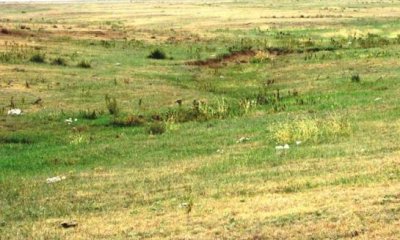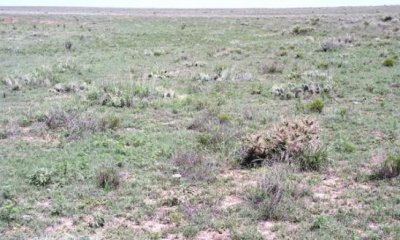
Draw 12-17" PZ
Scenario model
Current ecosystem state
Select a state
Management practices/drivers
Select a transition or restoration pathway
-
Transition T1A
Absence of disturbance and natural regeneration over time, may be coupled with excessive grazing pressure
More details -
Restoration pathway R2A
Adequate rest from defoliation and removal of woody canopy, followed by reintroduction of historic disturbance regimes
More details -
Transition T2A
Absence of disturbance and natural regeneration over time, may be coupled with excessive grazing pressure
More details -
Restoration pathway R3A
Adequate rest from defoliation and removal of woody canopy, followed by rangeland seeding
More details -
No transition or restoration pathway between the selected states has been described
Target ecosystem state
Select a state
State 1
Midgrass State



Description
The Draw site in 77B may host two slightly different plant communities depending on soil moisture. Where long-term soil moisture has been low, the Midgrass Dominant Community (1.1) will be dominated by midgrasses with lesser amounts of shortgrass species. Few tallgrasses, forbs and woody plants will be found.
In instances where soil moisture conditions are more favorable, Mid/Tallgrass Dominant Community (1.2) will still be dominated by midgrass species with a higher percentage of tallgrasses present and lesser amounts of shortgrass species. Forbs and woody plants will be more prevalent along areas that tend to pond water for longer periods.
Submodel
Description
Western wheatgrass acts as a strong increaser with initial grazing pressure. If abusive grazing is practiced for many years, western wheatgrass and other midgrasses will give way to increasing amounts of buffalograss and blue grama. These short grasses are better adapted to grazing pressure. The more desirable forbs decrease rapidly with abuse and western ragweed increases along with a host of annual forbs. In some cases, cool-season annual grasses such as Japanese brome and little barley will become excessive and compete strongly with perennials. Woody plants such as yucca and/or sand sagebrush often start to increase and become a higher percentage of the total composition. The decrease in density and stature of the mid and tallgrass species along with an increase in shortgrasses brings about a new plant community, the Shortgrass/Midgrass Plant Community phase (2.1).
Submodel
Description
If long-term heavy grazing continues, a threshold will be crossed to the Degraded Shortgrass/Annuals/Shrubs Community (3.1). In this degraded state, typical vegetation will be low vigor blue grama and buffalograss. Bare areas will open up with annuals filling the voids. Perennial threeawn will invade when the more desirable grasses are weakened and/or removed. Yucca and/or sand sagebrush will increase dramatically. Often pricklypear (Opuntia spp.) will gain a foothold on the site. Occasionally, broom snakeweed (Gutierrezia sarothrae) will increase to the point of domination. The loss of herbaceous cover and increased bare ground encourages accelerated erosion.
Submodel
Mechanism
The Midgrass State would shift to the Shortgrass/Midgrass State with heavy continuous grazing pressure, No fires, and no brush management practices.
Mechanism
With the implementation of rangeland conservation practices such as Prescribed Grazing over a three to five year period as well as Prescribed Burning and Individual Plant Treatment of brush management.
Relevant conservation practices
| Practice | External resources |
|---|---|
|
Brush Management |
|
|
Prescribed Burning |
|
|
Prescribed Grazing |
Mechanism
With continuous heavy grazing pressure, brush invasion, no brush management, and no pest management, the Shortgrass/Midgrass State may transition to the Degraded Shortgrass State.
Mechanism
With the implementation of various rangeland conservation practices such as Prescribed Grazing, Brush Management, Range Planting, and Pest Management, the Degraded Shortgrass State can be shifted to the Shortgrass/Midgrass State.
Relevant conservation practices
| Practice | External resources |
|---|---|
|
Brush Management |
|
|
Prescribed Grazing |
|
|
Range Planting |
|
|
Integrated Pest Management (IPM) |
Model keys
Briefcase
Add ecological sites and Major Land Resource Areas to your briefcase by clicking on the briefcase (![]() ) icon wherever it occurs. Drag and drop items to reorder. Cookies are used to store briefcase items between browsing sessions. Because of this, the number of items that can be added to your briefcase is limited, and briefcase items added on one device and browser cannot be accessed from another device or browser. Users who do not wish to place cookies on their devices should not use the briefcase tool. Briefcase cookies serve no other purpose than described here and are deleted whenever browsing history is cleared.
) icon wherever it occurs. Drag and drop items to reorder. Cookies are used to store briefcase items between browsing sessions. Because of this, the number of items that can be added to your briefcase is limited, and briefcase items added on one device and browser cannot be accessed from another device or browser. Users who do not wish to place cookies on their devices should not use the briefcase tool. Briefcase cookies serve no other purpose than described here and are deleted whenever browsing history is cleared.
Ecological sites
Major Land Resource Areas
The Ecosystem Dynamics Interpretive Tool is an information system framework developed by the USDA-ARS Jornada Experimental Range, USDA Natural Resources Conservation Service, and New Mexico State University.




